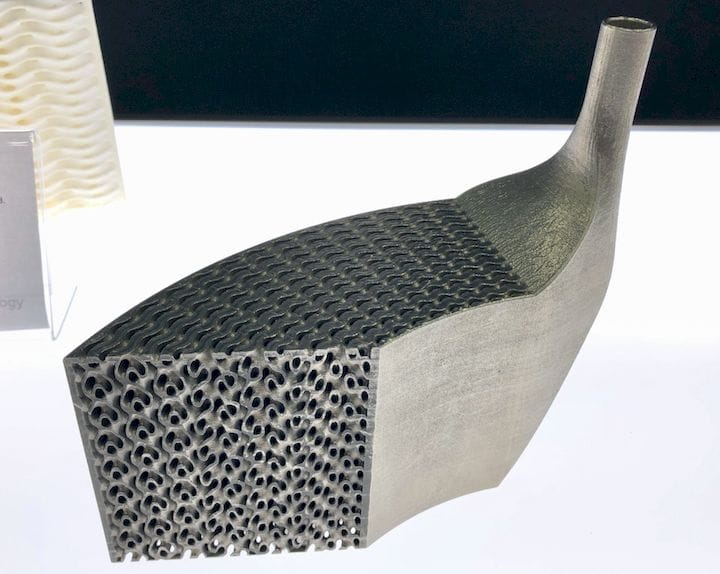![A complex 3D printed metal part designed in nTop Platform [Source: Fabbaloo]](https://fabbaloo.com/wp-content/uploads/2020/05/image-asset_img_5eb094ac0d405.jpg)
nTopology announced a revolutionary new tool for product design, nTop Platform.
The tool is a bit challenging to describe, as it is a hyper-mix of functions that are today often found in separate tools and products. But let me try to do so!
In the old world, product design followed a more conventional path: objects were designed in CAD tools, then exported for CAM processing or slicing for 3D printers. Iterative development took place by sharing the CAD models and/or examining made prototypes.
Enter 3D printing. This new technology allowed previously impossible structures, such as interior lattices, to reduce weight, or complex parts made in one operation, rather than being assembled.
That’s all fine, but exactly how does one do this? Yes, you can use a standalone tool to insert a lattice structure, but what is the RIGHT lattice structure?
This type of question is being raised more often these days, as we see a number of generative design tools emerge. There are tools that, given a set of objectives, can generate an entire structure from only the goals. There are other tools that optimize the topology of a part, say reducing overhangs. There are more tools to perform simulations. One may examine thermal stress, another mechanical. And a separate tool might inspect radio frequency penetration.
These tools are all very powerful, but they are most often found in separate environments.
The problem is that when one is actually designing a product that must traverse the entire design-to-manufacture lifecycle, the design teams find themselves constantly jumping across tools — in an inefficient manner.
Separate CAD Tools
Consider the case where a simulation tool examines the mechanical stress on a part. The idea is to chop out portions of the design that are not contributing significantly to the function, thus reducing weight and material used. However, tools very often simply present the stress as a continuous range of stress. This means that a designer must jump in and make a decision about where to “cut off” the material.
Similarly, generative design tools can very quickly develop a geometry that is optimal for a given scenario. However, these are almost always in a non- or poorly-editable form that reduces the generative output to an inspirational design rather than an actual CAD-editable object. Again, a designer must jump in and take over manually.
Now think about these kinds of issues when you have a multi-person team designing a very complex item that will require dozens or hundreds of design iterations. Imagine the inefficiency of that workflow.
That is what nTopology is working to solve.
Their nTop Platform product attempts to do so by using what they call “Field-Driven Design”. In their approach, the object is represented by fields of knowledge about each segment of the structure. The fields can be simple aspects such as position, but can also represent electromagnetic forces, thermal status, mechanical strain, and other complex attributes.
![Screenshot of nTop Platform in action [Source: Fabbaloo]](https://fabbaloo.com/wp-content/uploads/2020/05/image-asset_img_5eb094aca24a3.jpg)
nTop Platform is able to import CAD designs and convert them into a field representation. Once done, they can very rapidly perform all kinds of interesting operations that would be astoundingly complicated using other separate tools, such as combining the results of multiple simulations together to generate a new geometry, for example.
![Another complex 3D print designed with nTop Platform [Source: Fabbaloo]](https://fabbaloo.com/wp-content/uploads/2020/05/image-asset_img_5eb094aced685.jpg)
Handling Enormous 3D Models
Their algorithm is very capable of handling ridiculously large 3D models that would certainly choke other systems. For example, simulating a large radiator surface would be extremely difficult, but is easy in nTop Platform. They say:
“In field-driven design, users overlay the design, analysis, and manufacturing disciplines into one engineering model. Field-based geometry, simulation, and manufacturing algorithms can then leverage those fields to generate consistent and predictable results. This approach enables orders of magnitude increase in design iteration speed.”
In nTop Platform the results of a generated design are immediately available for further editing with CAD tools. In other words, they are usable, not merely inspirational.
On top of all this they’ve placed a communications layer that can enable project participants to work collaboratively. Iterations are easy, and productivity becomes much more efficient. In fact, the tool can be used to create and share highly complex design workflows.
The Future of Design For Additive Manufacturing
There’s tons more to this tool, and I encourage you to investigate further with nTopology directly.
My thinking here is that with nTop Platform we are beginning to see the release of design tools that are specifically able to take advantage of 3D printing technology; most tools up to now were firmly seated in older approaches. nTopology says it’s where “FEA meets CAD”. Now we get a glimpse of how the future of 3D design could unfold.
Via nTopology












1 comment
Comments are closed.